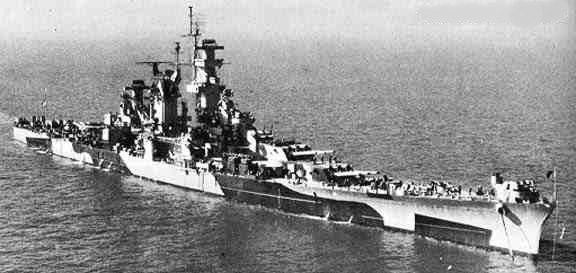

USS Alaska
SPECIFICATIONS
Displacement: 29,779 tons (standard), 34,253 tons (full load)
Dimensions: 808 ft 06 in length x 91 ft 01 in beam x 31 ft 10 in draft (full load)
Armament: 9x12in 45cal (3x3); 12x5in 38cal (6x2); 56x40mm (14x4); 34x20mm (34x1); 3 aircraft
Armor: Main belt 9-5in
ALASKA CLASS LARGE CRUISER
| Ship | Laid Down | Launched | Completed | Built By |
| CB-01 Alaska | 17 December 1941 | 15 August 1943 | 17 June 1944 | New York Ship |
| CB-02 Guam | 02 February 1942 | 12 November 1943 | 17 September 1944 | New York Ship |
| CB-03 Hawaii | 20 December 1943 | 11 March 1945 | Suspended 17 February 1947, 82.4% | New York Ship |
| CB-04 Philippines | Cancelled 24 June 1943 | --- | --- | New York Ship |
| CB-05 Puerto Rico | Cancelled 24 June 1943 | --- | --- | New York Ship |
| CB-06 Samoa | Cancelled 24 June 1943 | --- | --- | New York Ship |
Although these large cruisers are often considered capital ships (in view of their main batteries and their general appearance) in fact they were simple developments of US cruiser doctrine and requirements; they were in effect, heavy cruisers finally unencumbered by the Treaty limits of 8 inch guns and a maximum displacement of 10,000 tons. They are often described as white elephants, since by the time two out of the six originally ordered finally appeared in 1944 the tactical concepts which had inspired them had been completely superseded. However, that is not to deny their validity in the context of 1940, when nearly all senior US commanders afloat enthusiastically supported a 'super-cruiser' to replace the existing 8 inch type. It is often said, too, that these ships were imposed on the Navy by President Roosevelt, but such statements are at best difficult to verify. What is clear is that a 12 inch cruiser project surfaced in the Bureau of Construction and Repair as early as 1938, and that the President may well have inspired it on the basis of his notions of foreign 'battlecruiser' and 'supercruiser' development. Later discussions always began with the 12 inch ship, often designated CA2 to distinguish it from a conventional heavy cruiser (CA1) as one alternative in a spectrum of possible future cruisers.
Cruiser practice shows in the provision of one rather than two rudders (which, unfortunately, ensured a very large tactical diameter) and in the requirement for enclosed stowage for aircraft. This latter was responsible for the unusual aircraft arrangement: hull depth aft was too restricted to permit a hangar in the conventional location there. However, it should be noted that the abortive light and heavy cruiser designs of 1940, which were related to this one, also showed aircraft amidships; the Bureau of Aeronautics flirted briefly with this idea, but ultimately rejected it. In 1945-46 there were proposals to remove the two catapults and replace them with an additional pair of twin 5 inch/38 gunhouses; a single catapult (no hangar) was to be fitted on the fantail.
The 12 inch/50 guns were a new design and, because they were unique among wartime US ships, they were the most expensive heavy US guns of their period. The initial Alaska design called for eight guns in two triple and one twin turret, and the design finally adopted (three triples) was justified in part because it would simplify turret production. Armour was designed to assure immunity against the 12 inch 1140 lb shell between 18,000 and 24,000 yards at target angle of 60° - a requirement typical of prewar cruiser practice. The original characteristics specified the protection of machinery spaces only against 8 inch (cruiser) fire, but in view of the positioning of the 5 inch magazines in way of these spaces, the designers had to provide uniform protection against 12 inch fire there too.
Neither ship was modified during the war, and both were laid up soon afterwards. Hawaii was retained incomplete, at first for conversion to a missile ship; later she was very nearly converted to a command ship, a kind of larger sister for Northampton. They were expensive to maintain, and a poor substitute for a battleship; moreover, in the postwar naval world, even a Baltimore could quite overpower any Soviet cruiser, so that there were no more potentially hostile 8 inch cruisers to overwhelm - not to mention that, with a plenitude of carriers, surface commerce raiders presented rather less of a threat than prewar planners had imagined.

SOURCE:
Last Updated 24 January 2000

